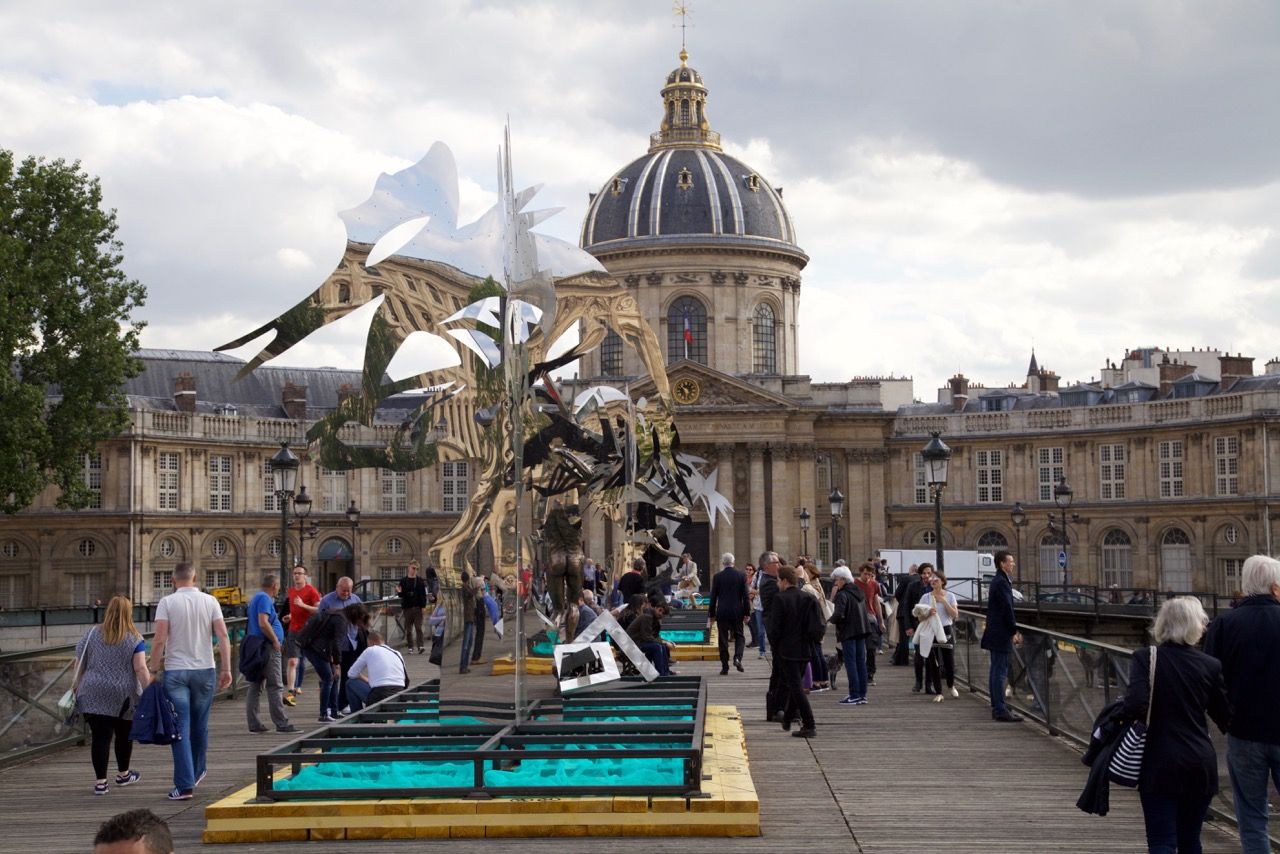
June 1, 2015 was the day the love died. That day an estimated one million padlocks, dubbed " love locks," were removed from Paris' famed Pont des Arts bridge—connecting the Louvre and the Institut de France across the Seine. Ironically, the city of love had fallen out of love with its unlikely tourist attraction.
The padlocks, weighing 45 tons, began accumulating on the bridge's railings around 2008. By June 2014, they were causing a strain on its infrastructure, and one railing collapsed. A year later, city officials diverted the path of true love for good. At the time, Paris deputy mayor Bruno Julliard said the locks had "spoiled the aesthetics" of the bridge and dubbed it an "ugly" trend.
Almost 12 months from the padlocks' removal, Parisians and tourists alike are being wooed back to the Pont des Arts in its latest incarnation: a destination for outdoor art exhibitions. The first display, unveiled Wednesday, is artist Daniel Hourdé's "La Passerelle Enchantée"—or, translated into English, "The Enchanted Bridge." The romance may be dead, but the magic is still alive.
Hourdé's exhibition will see the Pont des Arts adorned with large, steel tree sculptures. Between them, bronze sculptures of human beings "struggling and twisting in moments of extreme pain and joy." It marks the first exhibition on the bridge since 1999.
The sculptor tells Newsweek that in presenting "La Passerelle Enchantée" he has achieved, in a way, architects Louis-Alexandre de Cessart and Jacques Dillon's vision of a suspended garden when the bridge was first erected in the early 1800s. (It was rebuilt, following damage sustained in wartime, in the early 1980s.)
"The architect of the bridge wanted it to be a garden. I realized the initial project's [ambitions] by making a garden with trees of steel," says Hourdé. "The bridge was a garden for six months [when it launched] but it wasn't possible to [keep it as that]."
Hourdé's display will run simultaneously with his latest solo exhibition, "Grâce à Dieu," at the Galerie Agnès Monplaisir in Saint-Germain-des-Prés, Paris. Gallery founder Agnès Monplaisir, who represents the artist, was instrumental in the creation of his exhibition on the Pont des Arts.
"The bridge itself has always been a symbol for love and for the arts, the two things I value above all else," says Monplaisir. "Now, after the removal of the 'love locks,' we are preserving this identity through art, engaging everyone in an exciting new way."
For Monplaisir, "La Passerelle Enchantée" taking pride of place on the iconic bridge is a "dream come true.
"[The exhibition is] imbued with a sense of magic and myth uniquely suited for the Pont des Arts," she adds.
But what of the bridge's former life, as an elysium for windswept lovers? The city's decision to remove the love locks was met with some disappointment from romantics.
Speaking to Newsweek, Paris city hall defended the decision to remove the padlocks, saying: "They damaged the bridge's structure and could have caused accidents."
It has since replaced the railings with glass panels to deter any new love locks being added. Instead, city officials said lovers can "celebrate their union with a selfie [on the bridge] rather than by attaching locks.
"Lovers never needed a physical proof to express their love."
Although the love locks may be no more, Paris officials are hopeful the French capital will retain its moniker as the "city of love," and that the former love lock bridge will continue to attract visitors from around the globe.
"The Pont des Arts is a symbolic place," it said. "Paris is and has always been the city of love, and never needed locks for couples to celebrate their union. The bridge remains a lively and cultural place."
Uncommon Knowledge
Newsweek is committed to challenging conventional wisdom and finding connections in the search for common ground.
Newsweek is committed to challenging conventional wisdom and finding connections in the search for common ground.
About the writer
To read how Newsweek uses AI as a newsroom tool, Click here.








